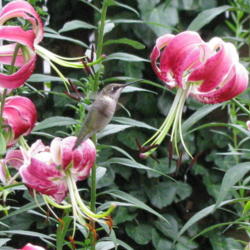
Asiatic lilies have a long vase life; however, when cutting them it's important to leave as much of the foliage as possible on the plant, to allow the plant to store energy for next year's blooms. Because the plants have relatively little foliage as it is, I prefer to enjoy the flowers right in the garden. If you want long-stemmed lilies for arrangements, I'd suggest you plant them in a special cutting garden and plan to plant new bulbs each fall. Note that the dark orange pollen can stain clothing and tablecloths; one solution is to remove the anthers before bringing them indoors.
Planting LiliesPlant lily bulbs in early spring or fall. Either way, they should be planted immediately after purchase. If you must wait a few days, keep the bulbs moist and store them in your refrigerator. In general, the bulbs should be planted at a depth of three times their height, which usually translates to a depth of 6 to 10 inches. Space bulbs 6 to 8 inches apart, or follow the planting instructions that come with the bulbs. Lilies prefer full sun and demand a well-drained soil. Ideally, the soil should be mulched or planted with a shallow-rooted, low-growing groundcover to help keep the soil -- and roots -- cool. Plant the tallest varieties at the back of the border, where adjacent perennials will camouflage ripening foliage. Tuck shorter varieties in between annuals in a sunny border.
Lily CareAsiatic lilies are relatively pest-free and easy to grow. Few diseases seem to bother them; however, slugs may damage foliage and buds. Also, the lily beetle is threatening to become a major problem. Look for a bright, orange-red, quarter-inch-long beetle eating the leaves - and if you find one, handpick and destroy it. The lily beetle has been in the US for several years and has recently found its way to the Northeast. The beetles' young larvae also feed on lily leaves and sometimes on lily buds.
Like tulips and daffodils, it's important to allow lily foliage to die back naturally, rather than cutting it back once the show is over. This allows the bulb to store energy for next year's blooms.
Asiatic lilies multiply quickly in favorable conditions, and will need dividing every few years. Divide them in the fall, after the foliage has died back. Lift the entire clump, separate the bulbs, and replant.
Suzanne DeJohn was National Gardening Association's reporter for the New England region until moving to Asheville, North Carolina, where she has assumed reporting for the Middle South region.
Photography by Suzanne DeJohn/National Gardening Association
Asiatic Lily TraitsOf all the lilies, Asiatic lilies are among the most reliable, pest-free, and easy to grow. Most are hardy in USDA Zones 3 to 10, making them appropriate for all of New England. As a rule, Asiatic lilies have tall, strong stems with 4- to 6-inch leaves radiating outward along the stem and clusters of flowers at the top. The flowers commonly have more or less recurved petals, and usually face outward or upward (as opposed to drooping). Unlike their Oriental cousins, Asiatic lilies have little fragrance. They bloom in early summer, often flowering for a month or more. Flower colors range from vibrant yellows, oranges, and reds, to subtle pastels, to pure white. After flowering, the plants' tidy foliage takes up little room in the garden, leaving plenty of space for later-flowering plants.

The stars of my perennial garden right now are the Asiatic lilies. If you judge a perennial by the amount of color it provides per square foot, or the ratio of flower to foliage, Asiatic lilies come out at the top in my book. No other flower provides such a burst of color, such a striking display of huge, long-lasting blooms.
Classifying LiliesAsiatic lilies belong in the genus Lilium, and are sometimes confused with that other popular garden plant, the daylily. Daylilies, along with lily-of-the-valley, calla lily, and water lily, are not "true" lilies; that is, they are not in the genus Lilium. True lilies include Easter lilies, Asiatic lilies, turks-cap lilies, tiger lilies, Madonna lilies, Canada lilies, and Oriental lilies -- in fact, there are almost 100 lily species, hundreds of hybrids, and about 7000 registered varieties! The history of lilies dates back thousands of years and, as is the case with other plants that have been cultivated for millennia, their classification is complex and hybrids abound.